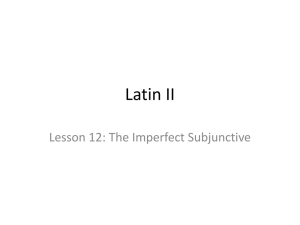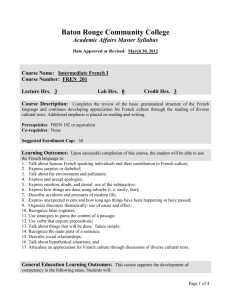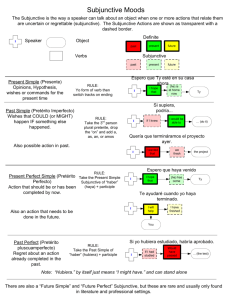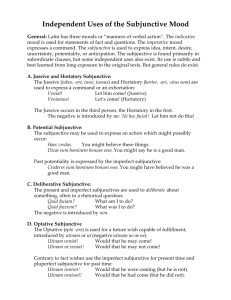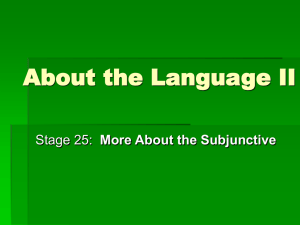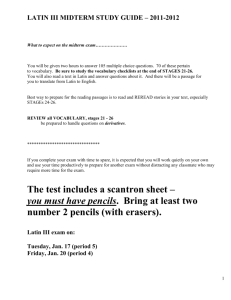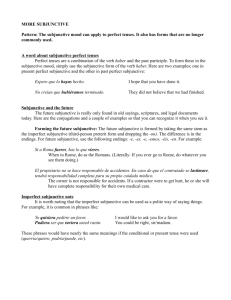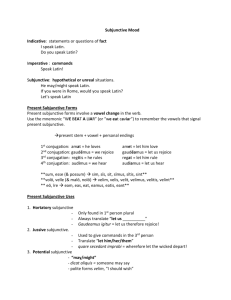The Origin of the Italic Imperfect Subjunctive
advertisement
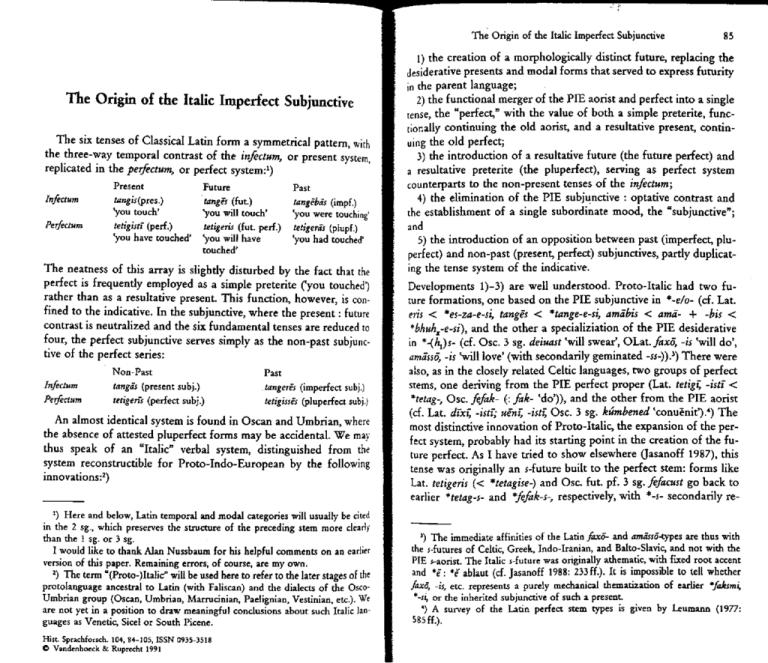
The Origin of the Italic Imperfect Subjunctive
85
1) the creation of a morphologically distinct future, replacing the
The Origin of the Italic Imperfect Subjunctive
desiderative presents and modal forms that served to express futurity
in the parent language;
2) the functional merger of the PIE aorist and perfect into a single
tense, the "perfect," with the value of both a simple preterite, funcrior,ally continuing the old aorist, and a resultative present, contin-
The six tenses of Classical Latin fonn a symmetrical pattern, with
the three-way temporal contrast of the inJectu"" or present system
replicated in the perfectu"" or perfect system:')
,
Infectum
Per/ectum
Present
tangis(pres.)
'you touch'
tetigislf (perf.)
'you have couched'
tanges (fur.)
Past
tangebas (impf.)
uing the old perfect;
3) the introduction of a resultative future (the future perfect) and
a resultative preterite (the pluperfect), serving as perfect system
counterparts to the non-present tenses of the infectum;
4) the elimination of the PIE subjunctive: optative contrast and
'you will touch'
'you were touching'
the establishment of a single subordinate mood, the "subjunctive";
tetigem (fut. perf.)
'you will have
tetigeras (plupf.)
'you had touched'
and
5) the introduction of an opposition between past (imperfect, pluperfect) and non-past (present, perfect) subjunctives, partly duplicat-
Future
touched'
The neatness of this array is slightly disturbed by the fact that the
perfect is frequently employed as a simple preterite ('you touched')
rather than as a resultative present. This function, however, is con-
fined to the indicative. In the subjunctive, where the present: future
contrast is neutralized and the six fundamental tenses afe reduced to
four, the perfect subjunctive serves simply as the non-past subjunctive of the perfect series:
Infectum
Peifecturn
Non-Past
tangas (present subj.)
tetigens (perfect subj.)
Past
tangeres (imperfect 5ubj.)
tetigissis (pluperfect subj.)
An almost identical system is found in Oscan and Umbrian, where
the absence of attested pluperfect fonns may be accidental. We may
thus speak of an "Italic" verhal system, distinguished from the
system reconstructihle for Proto-Indo-European by the following
innovations: 2)
1) Here and below, latin temporal and modal categories will usually be cited
in the 2 sg., which preserves the structure of the preceding stem more dearl)'
than the 1 sg. or 3 sg.
I would like to thank Alan Nussbaum for his helpful comments on an earlier
version of this paper. Remaining errors, of course, are my own.
') The term "(Proto-)Italie" will be used here to refer to the later stages of the
proeolanguage ancestral to Latin (with Faliscan) and the dialects of the OseoUmbrian group (Oscan, Umbrian. Marrocinian, Paelignian. Vestinian. etc.). We
are not yet in a position to draw meaningful conclusions about such Iealie languages as Venetie, Sicel or South Picene.
Hist. Sprachforsch. 104,84-105, ISSN 0935-3518
C Vandenhoeck & Ruprecht 1991
ing the tense system of the indicative.
Developments 1)-3) are well understood. Proto-Italic had two future formations, one based on the PIE subjunctive in '-elo- (cf. Lat.
eris < *es-za-e-si, tanges < *tange-e-si, amabis < ama- + -bis <
'bhuh.-e-si), and the other a specializiation of the PIE desiderative
in '-<~)s- (cf. Osc. 3 sg. deiuast 'will swear', OLat.ftxo, -is 'will do',
am4sso, -is 'will love' (with secondarily geminated -55-)).') There were
also, as in the closely related Celtic languages, two groups of perfect
stems, one deriving from the PIE perfect proper (Lat. tetigf, -ist' <
'tetag-, Osc. Jefale- (: ftk- 'do')), and the other from the PIE aorist
(d. Lat. d'xf, -ist'; uenf, -istf, Osc. 3 sg. kumbened 'conuenit').') The
most distinctive innovation of Proto-Italic, the expansion of the per-
fect system, probably had its starting point in the creation of the future perfect. As I have tried to show elsewhere (lasanolf 1987), this
tense was originally an s-future built to the perfect stem: fonns like
Lat. tetigeTis « 'tetagise-) and Osc. fut. pt 3 sg. Jeftcust go back to
earlier *tetag-s- and *fefak-s-, respectively, with *-s- secondarily re-
l) The immediate affinities of the Latin /axo- and amisso-types are thus wich
the s-futures of Celtic; Greek, Indo-Iranian, and Balta-Slavic; and not with the
PIE .s-aorist. The Italic s-future was originally athematic, with fixed rooe accent
and ',: 'e ablaut (d. Jasanoff 1988: 233ff.). It is impossible to tell whether
Jaxo. -is. eec. represents a purely mechanical thematization of earlier ·faksmi,
·~si, or the inherited subjunctive of such a present.
4) A survey of the Latin perfect stem types is given by 1..eumann (1977:
5851f.).
86
Jay H.Ja,anoff
The Origin of the Italic Imperfect Subjunctive
placed by *-is- in Latin and by *-us- in Osco-Umbrian.') The Lati"
pluperfect is an analogical pendant to the future perfect, made b\
substituting the synchronic preterite marker *-a- for *-e/o- On lh~.
model of the future: imperfect pairs er~ is: eTam~ -as and -bo, -bis: .
-bam, -bas.
The prehistory of the Italic subjunctive is more complicated. To
the extent that the attested forms have clear etymologies at all, thego back not to PIE subjunctives, which yielded futures, but to Pli
optatives. The most archaic modal forms in Latin add the optative
sign *-je~- / *-ihl - directly to an athematic present stem, as in
OLat. sie~ -is, 1 pI. slmus, and uelim, -is, edim, -is. The same formation underlies the obsolescent present subjunctives of the type /axim.
-IS and amassim, -is, properly optatives corresponding to the desiderative presents (> futures) /axo and amasso. The jaxim-type has all
analogue in the perfect system, where the perfect subjunctive leligerim, -is « *tetagist) stands in the same relation to the future per·
feet tetiger~ -is as /axim and amassim to /axa and amassa.') Conspicuously absent in Italic is any trace of the PIE "thematic" optative ill
*-oi- (i.e., *-0- + -i~-). The thematic presents of the second, third,
and fourth conjugations form their subjunctives with the mood sign
$-ti-, an element common to Italic and Celtic (d. Lat. tangas.. Osc.
deicans <dicant', OIr. ·bera <ferat').?) The first conjugation present
_,ubjunctives in *-ae- « *-aje- or *-aje-; d. Lat. ames, Osc. deiuaid
'IUret', Umbr. portaia 'portet') are more problematic: their Source is
probably to be sought in the small minority of first conjugation
\'erbs which go back to athematic presents in *-a- (*-ehz.-) Or *-a('-h,-) with optatives in *-jeh,- / *-i~-. A derivation from the PIE
"long vowel" subjunctive in *-aje- (i. e., *-eAJe-e!o-), though fa'ored in the older literature, is unlikely on functional grounds.')
By far the most puzzling innovation of the pre-Italic period - and
the only one that will concern us here - was the creation of the distinctive "past" subjunctives of the type tangeres (imp£. subj.) and tetigisses (plpf. subj.). The use of the imperfect and pluperfect subjunctive in Latin, and apparently also in Oscan and Umbrian, is in large
part regulated by the rule of .Sequence of Tenses' (ST), which governs the succession of tense markings in complex sentences. The effect of the rule is very simple: in certain common types of subordinate clauses that require t~e subjunctive, a past subjunctive appears
if and only if a past tense appears in the corresponding main clause.
So, e.g., in indirect questions:
~) The *-u- of Osco-Umbrian *-us- is ultimately due to the influence of (hI'
verb */U- 'be(come)', which historically fonned a future perfect ·/e/uSl < "fefiH
(d. Umbr. 3 pl.fefi<re) and a perfect 'fefed < '/efi!- (d. Buck 1928, 173,362 >oJ
already Brugmann 1880: 40). The more problematic *-i- of Lat. *-is- SWll\
originally to have been a union vowel, imported into the future perfect from tl1l'
perfect indicative (d. dfxislf < *deiks-i-stai, dfximus < *deiks-i-mos, etc.). Tht'
source of *-ithe indicative is perhaps to be sought in the u-perfecti'of longvowel roots, where Proto-Italic inherited 1 sg. and 3 sg. fonns in *-o}! from lat(
PIE (d. Ved_ tastnau 'stands', etc.). When the perfect endings were extended h~
the hie et nune particle *-i in pre-Latin (d. teligf < *-a-i, tetigit < *-e-i[t], wi·
gire < *-iT-i). the paradigm of the nascent u-perfects would have become
1,3 sg. *gno}!~ *si}!i, *stra}!i
2 sg. *gnostai, *sistai, *slristai
1 pI. *gnomos, *semos, *slramos, etc.
The morphologically opaque .!:Ii-element was subsequently extended to d1l'
other persons and numbers, giving rise to *si}!istai, *sitfimos, etc. The final wr
was the analogical replacement of *-.!:Ii by *-J!tZi in the 1 sg. and *-.!:Iei[ t] in the -'
sg., leaving *-i- "stranded" as a union vowel in the 2 sg., 1 pl., and 2 pI.
') Note that the absence of a reflex of *-je- in uelim, -is and edim, is is nOl
due to analogical leveling, but reflects the fixed root accent of these forms, whKh
took the zero grade of the optative suffix in the singular as well as the plural (d.
Narten 1968). Since fixed root accent was also a feature of the athematic s-pre~'
eots (d. note 3), the typesfizxim. ~is and tetigerim. -fs have invariant -t- as well.
in
87
I) nescia quid/aciiis (pres. subj.) I ftcecis (perf. subj.)
'I don't know what you are doing I have done'
but
2) nesciebam quid/aceres (impf. subj.) / ftcisses (I'll'£. subj.)
'I didn't know what you were doing I had done'
7) Cf. ]asanoff (1983: 75ff.), where it is suggested that langis, dfeiis, etc., and
their Cltic counterparts, along with the imperfects eras (: MW 3 sg, oed 'was')
and -biis (: OIr. 3 sg ba 'was') originated as preterites in *.Jr,.- to inherited sublunctives-often aorist subjunctives-in *-e!o-_ The a-optative was primitively inM
dependent of the present stem; traces of this state of affairs can still be seen in
forms like Olat. attigas and aduends for classical attingis, aduenias. A distant
connection with the"a-preterites" of T ocharian and Balto-Slavic is likely.
S) Here and below, I write *-ai- rather than the usual *·iie- for the ProtoItalic forms because it is unclear whether the inherited nucleus of the type was
provided by verbs like TenoudTe, with presents in invariant *-12- and optatives in
original *~a-je- < *-ehz-jeh c (d. Hitt. newa!J.!J- 'make new'), or by verbs like indintire, with presents in *-(n)a- / *-(n)J- and optatives in earlier *-(n)J-je- <
*-(n)hz-jen.-. The great mass of first conjugation presents, of course, had pres-
ents in '-iije/o- ('-eh,-jelo-) and 'optatives' in '-aja- (> '-a-); modal fonns of
this kind are still nonnal in Celcic (d. aIr. -glana 'pucgat, purget'), but have been
eliminated from Italic, presumably owing to their near homophony with the
indicative. Umbrian -aia- shows the addition of the productive subjunctive sign
*·ti. to the phonological reflex of *-ai- (d_ Buck 1928: 174)_
88
Jay H.Jasanoff
And in purpose clauses:
3) es ut UlutiS (pres. subj.)
'You eat that you may live' ( = 'You eat to live')
but
4) edebiis ut ulueres (impf. subj.)
'You were eating that you might live' ( = "You were eating
live')
The Origin of the Italic Imperfect Subjunctive
to
ST is thus in essence an agreement role which copies the value of tht
feature [± past] from the verb in a matrix sentence to the verb in an
embedded sentence. Agreement marking of this kind is very Common in modem European languages, including English, where the
contrast between sentences like "I don't know what you are doing»
and "I didn't know what you were doing," as in the above glosses, is
as much a part of the language as the contrast between Jacias and ftceres in Latin. (English, of course, uses the indicative or a modal auxiliary in such cases.) Among the older IE languages, Attic Greek employs the subjunctive in a variety of subordinate clauses after a present or future, but uses the optative after an imperfect or aorist, thus
duplicating the effect of ST with a rule of "Sequence of Moods." A
case can be made for positing such a rule, with the optative serving
as the "past" of the subjunctive in certain contexts, in the parent Ian·
guage.
In Italic, where the PIE optative (or its successor category, the i·
subjunctive) was prehistorically substituted for the old subjunctive in
all its modal functions, the contrast between [+past] and [-past] in
subordinate clauses is necessarily. expressed by different means. The
mark of the past subjunctive in Latin and Osco-Umbrian is a suffix
reconstructible as *-se-, which is added to present stems to form the
imperfect subjunctive, and (in Latin at least) to perfect stems to form
the pluperfect subjunctive. Since the overwhelming majority of present stems end in a vowel, the typical outcome in Latin is -re- in the
imperfect subjunctive, with regular rhotacism of intervocalic *-s- to
-r- (d. tangeres, jaCeTeS, amires, etc.). Unrhotacized -se- is preserved
after -5- in the verb 'to be' (impf. subj. esse~ etc.; pres. stem es-), and
assimilates to a preceding -1- in the verb 'to want' (impf. subj. uelleJ,
etc.; pres. stem *J!el-).9) In Oscan, where there was no phonological
89
change of *-s- to -T-, -se- is directly attested in fonns like impf. subj.
3 pI. patens,ns < *patne-se-nt 'panderent' and 3 sg. /us'd < *jU-se-t
'esset', the latter with a synchronically isolated Latin cognate in the
irregular imperfeer subjunctive joret. 1O ) The Latin pluperfect subjunctive in -isse- shows the addition of *-se- to complexes of the
Ivpe *tetagis-, which were extracted as synchronic perfect stems from
the future perfect (*tetagiselo-), perfect subjunctive (*tetagisl-), and
pluperfect indicative (*tetagisii-).
The origin of this morpheme is unknown. After more than a century of ingenious but inconclusive etymological proposals, the only
result on which scholars are generally agreed is that there was no
suffix of the required shape in PIE, and that the seemingly unanalyzable sequence *-se- must therefore once have contained a morpheme
boundary. In practice, the search for an explanation of the imperfect
subjunctive has typically reduced to the search for a PIE or pre-Italic
'-s-, and a PIE or pre-Italic *-e-, with meanings that could have
combined to yield the required past modal sense.")
There are two obvious candidates for the s·dement. The traditional favorite is the *-s- of the PIE sigmatic aorist, a formation represented in Latin by perfects of the type dlx~ -ist!. Many scholars
(e.g., Thumeysen 1884: 275, Buck 1933: 301) have traced the imperfect subjunctive to an earlier" e-subjunctive" of the s-aorist. But how
and why such a tense-mood combination would have given rise to a
modal category in Italic is unclear, since the PIE subjunctive is
otherwise known only to have yielded Italic futures (d. tanges,
eris).") There is also a fonnal problem. Since the PIE s-aorist was an
athematic category, with a stem that ended in simple *-s- rather than
*-Sf/O-, its subjunctive in the parent language was marked not by
'-se- (i.e., *-se-elo-) but by *-,-elo-, which would ultimately have
course, to the accident that the Latin infinitive goes back historically to the loco
sg. in *-i of an s-stem verbal noun.
10) In Oscan intervocalic *-s- was voiced to -z-, but the change is not represented in the native writing system.
11) In the discussion that follows, the term "imperfect subjunctive" is in part
simply an abbreviation for the more unwieldy "imperfect and pluperfect subjunctive." But the form of the pluperfect subjunctive in Latin, which presupposes a
reanalyzed perfect stem *tetagis-, makes it likely that the imperfect subjunctive is
in fact the more archaic of the two categories.
') The descriptive rule that the imperfect subjunctive is made by adding per·
sonal endings to the present infinitive (d. tangere, facere, esse, uel/e) is due, of
12) Buck (op.cit.. 301) glosses the e-subjunctive of the s-aorist as "'a future of
the past, which is a rational basis for the actual uses of the tense." He cites no
typological parallels; one suspects that he has confused "future of the past" with
the much more usual "past of the future" (see below).
90
Jay H.Jasanoff
yielded Latin forms of the type 'tangeri' rather than the atte",d
tangeres. Such "short vowel" subjunctives of the s-aorist are well :II
tested in Homeric Greek and Vedic Sanskrit; it is hard to see wl1\
they should have been replaced by forms in '-e-, proper only t;,
thematic stems, in Italic.
The natural alternative is to consider the possibility of a COnntl
tion between the '-f- of '-,e- and the PfE optative suffix • -ii- .
'"-f-. Here too the initial signs are discouraging. As can be seen fro11l
forms like the Latin pronominal genitive eius < *esjo + -5, the k.
quence *-5)- was not regularly simplified to *-5- in Italic. In prin.
ciple, the combination *-5- + *-e- could also have come about arlJ·
logically, through the secondary extension of '-e- to the ,-aori"
from a category such as the subjunctive type ames~ where *-je haJ
become "'-e- by regular sound change. But it is not at all clear wIn
the formally and functionally remote ame'-type should have induced
the nascent imperfect subjunctives in *-sje- (*amtisje-, *fakisje, etc)
to give up their '-j-. An altogether different reconstruction 01 the
optative suffix is therefore favored by Hirt (1915: 140ff.), who eil<'1
the Greek s-aorist optatives in 3 sg. -seie, pI. -seian (type deixei{'
(pres. de,knumi» and the Old Prussian "optatives" in -Sfi (e.g., bo,;Sfi 'would be' (: Osc. jUs,d, Lat. /oTet?» to argue for a special PIE ;aorist type in *-s-ei-. In Italic the combination of *-s-ei- with the
endings of the 1 sg. and 3 pI. would have yielded preforms in • -s-e)tp and *-s-ej-vt; these, in Hirt's view, developed via *-sejem and *-srient to *-sem and *-sent, from which *-se- was analogically extended to the other persons and numbers. Neither the Baltic nor the
Greek comparison, however, can any longer he upheld. It is no\\
clear that Gk. -Sfie rests on older -,ie, which is found in Cretan di,leet inscriptions; OPr. -sei is a development of the s-future rather
than of the ,-aorist, which is unattested in Baltic.") In a carelui
study of the relevant Indo-Iranian evidence, Hoffmann has pointed
out (1968: 246, fn. 4; ef. below) that there was probably no ,-aorist
optative in the parent language at all.")
The Origin of the Italic Imperfect Subjunctive
According to an isolated suggestion by Safarewicz (1952: 103ff.),
imperfect subjunctive was originally the "e-preterite" of an s-aorl,l indicative. But even if it could be shown-and it cannot-that
Itllic once had a preterite suffix *-e-, the semantic basis for Safarewia' proposal would remain unintelligible. is)
The other possible source of the '-s- of '-,e- is the '-,- of the
piE desiderative/future. A priori, a connection of the imperfect sub;unctive with me Italic s-future (Lat. /axis, Osc. deiuast) would seem
.It least as attractive as a connection with the s-perfect. "Desiderative" -s- was highly productive in Italic, where it gave rise to a whole
new tense, the future perfect; the ,-perfect « aorist), by contrast, is
limited in its distribution in Latin and is not found at all in OscoUmbrian. Morphological links between futures and modal forms are
tvpogically very common; familiar examples from modern languages
i;ldude the English pair will: would and the Romance future and
conditional in -T- (ef. Fr. chanteTa 'will sing': chanteTait 'would sing',
de.).") Yet the prospects for explaining the imperfect subjunctive as
J, subjunctive or optative of the desiderative are poor. The possibility
of a long vowel subjunctive in *-s-e- can be dismissed out of hand:
~ince *-s- and *-e- each imparted future meaning separately, it is inconceivable that they could have yielded anything but a future when
used together. A desiderative optative in *-s-ie- / *-s-i-, analogically
transformed to eliminate the *-j-, would make better sense from a
functional point of view. But the optative of the desiderative is already attested in the Latin type /axis, amassfs, etc., and these are present, not imperfect subjunctives. Cowgill (1973: 292, fn. 41) makes a
valiant attempt to keep the desiderative possibility alive by taking
*·se- as the synchronic subjunctive in -e- (d. ames) of a present in
*-sa-. Under this analysis, Lat. fores would represent the present
~ubjunctive of a lost first conjugation indicative *foras I you wish to
be'. Cowgill's proposal, however, is too contrived to be convincing,
and it is badly compromised by the fact that the 3 sg. subjunctive of
tilt'
*-e- meant by Safarewicz is the morpheme that underlies the "'i-aoeof Greek (e.g., 3 sg. epluine to phatnomai) and Balto-Slavic (e.g., OCS 3 sg.
mhne'thought' to pres. 3 sg. mbnin). The use of this element as a preterite
marker is a post-IE development that was not shared by Italic; d. Jasanoff (1978
passim).
I") Similar "'conditionals" based on futures, all with uses partly overlapping
those of the Latin imperfect subjunctive, are found in Sanskrit (bluwijyali 'will
be': abhavifYat 'would be') and Old Irish (mt5irjid 'will magnify': no-m6irjed
'would magnify).
IS) The
H) The critical Greek forms are the optatives kosmesie and dikaksii, which
show that the -ei- of the classical (UAeolic") type deixeie is an inner-Greek crea·
tion (d. Rix 1976a: 232£.). On the Prussian fonns d. Stang (1966: 442f.).
14) Verbs with s-aorist indicatives and subjunctives originally built their aori51
optatives directly from the unsigmatized root; d. Ved. aor. indic. yaU}-, or. subi,
yo§a-, but aoe. opt. yiiya- (: yu- ward off». The absence of inherited forms in
*-sji- makes it unproductive to speculate on the possibility of an ad hoc Italic
phonological rule that simplified II<_sj_ to ·-s- after stops.
91
IStS"
92
Jay H.Jasanoff
The Origin of the Italic Imperfect Subjunctive
an Italic present "!Usa- would have appeared as ";maid, not/usid, i"
OscanY)
To summarize, the problem of the origin of the imperfect sub.
junctive has not responded well to what might be called the "Com.
binatory" approach - the technique of decomposing a complex mOr.
pheme (here *-se-) into its presumed constituents (here
*·5-
and
"-eo) and attempting to etymologize these separately. Ordinarily tbe
method is quite successful. The handbooks of Latin, and of even
other IE language, offer countless examples of suffixes whose hi;.
tory is basically revealed by the judicious insertion of a hyphen: the
-ba- of the Latin imperfect can be analyzed as -b-ii-, the preterite in
-ii- of the auxiliary -b- < ".bhlf- 'be'; the adjectival suffix -iinus i,
etymologically -a-nus~ the sequence that arose from the addition of
*-no- to a-stem nouns; and so on. In the case of the imperfect subjunctive it is not the segmentation *-s-e- that raises problems, bUI
the next step-the identification of the elements "-s- and "-e- with
recognizable PIE morphemes. The first term is in all likelihood the
marker of the aorist or desiderative, but neither alternative is obvi·
ously preferable to the other; the second is presumably a mood sign.
but the Italic treatment of the IE moods is so confused that no clear
choice can be made between the subjunctive (formally straightfor.
ward, functionally difficult) and the optative (functionally straightforward, formally difficult). None of the four possible combinations
tive was first recognized and addressed by native speakers. The part'nt language, as we know, had two subordinate moods, which, to
lodge from the Greek Sequence of Moods rule, may originally have
heen used in ways that approximated the use of the present and past
wbjunctives in Latin. But the PIE situation was transfonned in
italic, where the subjunctive became a future, and the only modal
category that remained, other than the imperative, was the optative.
Thus, there must have been a period in the evolution of Proto-Italic
when there was no fonnal distinction between the two "subjunctives" (= optatives) in sentences like
;) One skiD
(~
Lat. nescio
'I don't know
and suggested ways - or left it to the reader to imagine ways - that
the combination *-s-e- could have acquired the functions associated
with "-se- in the attested languages. As we shall see, there are advantages to be gained from a less PIE-centered, more "synchronic" ap-
proach - one that focuses on the state of the Proto-Italic system at
the critical moment when the need for tense marking in the subjunc-
k-id
quid
jakiiis / jaks's
faciiis (pres. subj.))
what
you are doing'
and
6) One skiejiim
(~
Lat. nesciebam
'I didn't know
k-id
quid
jakiiis / jaks's
"jacias (for impf. subj. jaceres»
what
you were doing'.")
It is against the background of the grammar that produced sentences
5) and 6) - a grammar with no contrast between present and past
subjunctives, and therefore also with no ST rule - that the substitution of the new imperfect subjunctive "jakises (> Lat. jaceres) for
'Jakiiis / "faks's in 6) must be understood.
yield the required composite meaning - past subjunctive - in any
simple way.
The problem, however, can be viewed in a completely different
light. Past attempts to explain the imperfect subjunctive have typically proposed one or another identification of the *-s- and *-e-
93
to
That the speakers of Proto-Italic would have found it expedient
attach the feature [ + past] to an embedded verb in "secondary se-
quence'" (i.e., after a [+past] main verb) is not surprising, given the
cross-linguistic frequency of interclausal tense agreement rules.
Other IE languages which have lost the subjunctive: optative opposition have similarly introduced a distinction between past and non-
past varieties of a single subordinate mood, among them Celtic and
Germanic, the immediate neighbors of Italic to the west and north.
In these languages the origin of the forms that function as past subjunctives is clear. The Insular Celtic languages make their past subjunctive by adding the endings of the imperfect indicative to the subjunctive stem, thus creating, in effect, an imperfect of the subjunctive
17) Cowgill suggests that ·-i- waS the regular contraction product of ·-ae-.
and that the treatment seen in Osc. deiuaid was analogical. By 1980, however, he
had abandoned this idea, and suggested to me in a personal communication that
·/me- might better be interpreted as an i-preterite of the s-future. The latter proposal was perhaps influenced by Pedersen (1921: 14 f.), who derives the imperfect subjunctive from a "conditional" (i.e., a preterite of the future) in .+7]1
(> ··sem), ·-s-s, ·-s-t, subsequently enlarged by the ·-i- of amem, -is.
"J These examples, of course, are merely intended to illustrate a stage of
Proto·Italic when there was as yet no tense agreement between matrix verbs and
subjunctives in embedded clauses. The particular choice of syntactic frame is arbitrary; similar sentences could have been constructed using a variety of other
clause types.
94
Jay H.Jasanoff
(cf. OIr. pres. subj. dO'bera 'may give', past subj. dO'berad 'might
give', formally comparable to do "goa cchooses'. impf. do"goad 'used to
choose'). Translated into Italic terms, this procedure would h",.
generated imperfect subjunctives of the type Lat. */aciabam, -bas Or
*/axi(e)bam, -bas, which are not found in any actually attested I"h,
dialect.
The model of the past subjunctive in Germanic, however, is mOrt"
instructive. The forms that pattern as past subjunctives in this branch
of the family are etymologically simply optatives of the preterite.
i. e., optatives of the PIE perfect (d. Go. tekan 'touch', pret. 3 sg. lattok, pret. subj. taitoki).") The transformation of the perfect optative
into a true past subjunctive in Germanic was triggered by two devel.
opments with close typological parallels in Italic - the elimination of
the PIE subjunctive as a distinct mood and the conversion of the
perfect indicative into a simple preterite. With the loss of the old
subjunctive, Proto-Germanic entered a linguistic stage comparablt
the Italic stage represented by sentences 5) and 6). Its response to
the absence of tense distinctions in modal subordinate clauses was to
replace the optative of the present by the optative of the preterier!
perfect in [ + past] environments.2D) What, we may now ask, would
have been the analogous development in Italic? The only synchroni..
subjunctive associated with a past tense in early Proto-Italic was the
subjunctive of the perfect. The Italic perfect was functionally as well
as formally a conflation of the PIE perfect and aorist; Lat. tetig,
-ist! still means both 'have touched', with a development of the old
perfect meaning, and (touched', continuing the value of the old aorist. Since there were no modal forms of the imperfect in PIE, and
1') This is true at least for strong verbs; the origin of the preterite optative !11
weak verbs is necessarily bound up with the problem of the origin of the weak
preterite itself.
20) It is easy to see why this happened. In Proto-Germanic; as in every other
early IE language, there were many kinds of subordinate clauses-those conveying information assumed to be factually true, for example-that regularly employed the indicative. For obvious semantic reasons, such clauses would routinely have used the preterite « perfect) after a main verb marked for past time,
just as, e.g., Eng. I know that Edward is king translates, in the past, to I knew thd{
Edward was king. It would have been a trivial step for this agreement pattern to
spread to clauses that required the subjunctive, with the subjunctive of the pret"
erite (= the old perfect optative) substituting for the present subjunctive in
[+past] contexts. The result was the simple sequence of tenses rule seen, e.g., in
Go. jah athaitands sumana magiwe /rah-uh Iva wesi jJata 'and calling one of the
lads, asked (pret.) what that [clamor] was (pret. subj.)' (Luke 15,26).
The Origin of the Italic Imperfect Subjunctive
95
,illce the perfect and aorist were no longer distinguished in early
Proto-Italic, the "Germanic" treatment of sentence 6) would have
been to substitute the perfect subjunctive - the structural counterpart
"f Lat. ftcer!s- for */akias / */aks!s.")
The form of the perfect subjunctive in Proto-Italic is seldom explicitly discussed. In Latin, as noted earlier, the perfect subjunctive in
"'-5i- (tetigerim, -is; ficerim, -is, etc.) is an optative of the s-future of
[he perfect, i.e., the future perfect (tetigerD, -is; jecerD, -is, etc.), just
;l~ the present subjunctive in *-si- (faxim, -is, etc.) is an optative of
the simple s-future (/axi5, -is). As such, the tetigeTim-type represents
.111 innovation that can be no older than the creation of the future
perfect itself; to judge from the absence of comparable forms in
()sco-Umbrian, it may be considerably later. A priori, we might have
t'xpected that Proto-Italic would have inherited a more archaic type
of perfect subjunctive based directly on the unsigmatized perfect
slem, just as in the present system the non-sigmatic /acias, based directly on the present stem, is firmly entrenched beside/axrs. No such
,-less (or rather r-Iess) forms are found in Latin, but they are well-attested in Oscan and Umbrian, where they supply our only examples
of the perfect subjunctive in these languages. Significantly, the
Oseo-Umbrian perfect subjunctive is formed with the mood sign
"l<·e_ -a fact which is obscured, but not concealed, by the conventions
of Oscan orthography. The high mid vowel that developed from
PIE *e in Oscan is not distinguished from the reflex of PIE *r in inscriptions written in the Latin alphabet; perfect subjunctives like
) sg. fe/acid 'may have done, fecerit' and jUid 'may have been, fuerit'
can as easily go back to preforms in *-i- as in *-e-. But the ambiguity is resolved in favor of *-e- by the forms 3 pI. tribarakattfns <aedificauerint' and 3 sg. pass. sakrafir 'sacratum sit', both written in the
native Oscan alphabet and using the special symbol f to represent a
lower vowel than i. 22 )
The Osco-Umbrian-and no doubt Proto-Italic-perfect subjunctive in *-e- thus takes its place beside the imperfect subjunctive in
*-se- and the first conjugation present subjunctive in *-ae- as the
third Italic category in which the vowel *-e- functions as a mood
II) The assumption that the PIE perfect and aorist had already fallen together
is important for the argument that follows. See, however, note 36.
22) The evidence for the mood sign of the perfect subjunctive in Umbrian is
completely ambiguous; d. Poultney (1959: 137). The fo~ herifi, li~ted. as a ~["­
feet subjunctive in the older handbooks, has been attractlvely explamed as an tn·
finitive by Rix (1976b).
96
Jay H.JasanoH
sign. Its origin in this case is relatively clear. A PIE e-subJ'unctive ,h
proposed, e.g., by Buck (1928: 175), is excluded on the familiar <,.
mantic and morphological grounds: not only do PIE subjunctiv,.,
normally give Italic futures, but most of the PIE stem-types that un
derlie the Italic perfect were non-thematic, and hence would regu.
larly have formed short vowel subjunctives in the parent language.ill
The optative sign *-je- / *-i- offers a better, and indeed the onlrealistic point of departure. Since intervocalic *-j- was lost in th~.
Proto-Italic period, *-je- would have given *-e- by normal Sound
change in the optatives of vowel-final perfect stems. Osc. jUIJ
[fued], which can be exactly equated with the Vedic Sanskrit rom
aorist optative bhuyJ/;l, is the most striking example of this kind'''1
The root *p-, however, is not isolated: Latin perfects of the typt'
seu;; pieul; and straui; are almost certainly late replacements of roO!
aorislS *se- (*seh,-), *ple- (*pleh,,-), and *stTii- (*stTeh,-), the regular
optatives of which, before the loss of *-i-, would have been *saie·
( *sh,-jeh,,-), *pliije- (*Pih" -jeh,,-), and *st;iije- (*st[h,-jeh,- ).25) Fr~1ll
such forms, *-e- was evidently extended to the great mass of perfen
stems that ended in a consonant.
The replacement of *-je- by *-e- after consonants, which wa~
probably an Italic rather than a purely Osco-Umbrian development,
was favored by a number of special circumstances. In perfects of the
reduplicated type, optative forms like 3 sg. *fejak-je-t would regu·
larly have retained their postconsonantal *.j_.26) No *-j- appeared,
however, in the corresponding plural fonns, which were based on
the weak optative stem in *-1-. The *-je- / *-i- alternation would
have led to difficulties in cases where the perfect stem ended in *-g.
or *-d-. These consonants were completely assimilated to a follow23) The only thematic perfect stems in Italic were those based on old thematic
aorists; such perfects might have been expected to fonn subjunctives in *-ii·, replacing PIE thematic optatives in .-oj-.
H) Ved. bhiiyaft, with the "precative» ending -b < *-st, is an inner-Indic replacement of Indo-Iranian *bhuyat (: Avestan biiiiil).
2S) These forms, of course, were eventually replaced in Latin by regularized
perfect subjunctives built to the new indicatives in -u- (seueris, pleuens, strauens);
d. note 5. Other perfects that would have lost intervocalic ._j- in the optativl.'
were the Italic counterparts of gn5u~ piu~ and eriuf (both 'I have separated'
and 'I have grown').
26) The choice of the perfect stem */e/ak- as an example is convenient in vic?:
of Osc. fe/acid, but it is not all clear that this verb actually fonned a reduplicated
perfect in Proto-Italic. Lat. fief, -istf, which matches Gk. etheka, probably reflects the more original formation.
The Origin of the Italic Imperfect Subjunctive
97
*-j- in Proto-Italic; examples of the change in Latin include the
nW1paratives maior [maiior] < *mag-jos and peioT [peiior] < *pedI()S. The subjunctives corresponding to the Latin perfects tetigi and
:ceidi (: pres. cado) would thus have emerged in Proto-Italic as *telujji- / *tetagi- and *kekaiie- / *kekadi-, with *-ii- for *-gj- and
"'-dj-, respectively. The morphological opacity of *tetaije- and *kekdjif- would have made them prime candidates for analogical re~[ructuring. Since the dusters *-gj- and *-dj- were phonotactically
prohibited, the simplest way to restore the integrity of the perfect
~tl;'ms *tetag- and *kekad- would have been to generalize the pattern
Jtready established in perfect subjunctives of the type */ue- / */ui-.
The proportion was simple:
lilg
*/ui: */ue- :: *tetagi-, *kekadi-: X; X
~
*tetage-, *kekade-.
Once generated in this way, the new *tetage- and *kekade- would
nJturally have helped trigger the replacement of the type *fefakjehy *fefake-. Eventually, the weak stems *tetagi-, *kekadi-, */ui-, and
*fe/aki- were eliminated by inner-paradigmatic leveling. 27 )
The newly transformed mood sign *-e- was subsequently generalized to the other perfect types. The mechanism by which *-je- was
replaced by *-e- in the "long-vowel" perfects) both old root aorists
like Lat. ueni (: Osc. kumbeneti)28) and true perfects like Lat. emf,
was probably the same as in the case of *tetage- and *fefake-. In the
i-perfects (dixf, etc.) the details are less clear. Here there were probably no forms in *-s-je- or *-s-i- in the parent language at all; as
pointed out by Hoffmann (d. above), there is good reason to believe
that the optative of the PIE s-aorist was a suppletive formation built
directly from the verbal root. The perfect subjunctive corresponding
to Lat. dixf, originally based on a non-sigmatic stem *dikje- or
*deikf-, was eventually transformed to *deikse- in Italic, but the ex27) This is basically the explanation of Osco-Umbrian ·/ue- and */e/akigiven by Lindeman (1982: 303ff.). But Lindeman wrongly tries to derive the
Latin perfect subjunctive /uen- from the same original paradigm as */ue-, taking
"fue- from the strong stem *bhu.je- and /uen-, despite its *-is-. from the weak
stem *bhu-f-. He is thus forced to treat the invariant "'-e- of Osco-Umbrian as a
post-Italic innovation.
28) It is worth noting, perhaps, that uenf and kumbened go back to the same
paradigm. The Latin long vowel, which is also found in Tocharian, arose by inner-PIE sound change in the 1 sg. and 2 sg., where underlying *gPim-m and
·g~em-s both regularly gave *gPim within the parent language. (In the case of
the 2 sg. lowe this observation to Alan Nussbaum.) Latin generalized ·-e- to the
whole paradigm, while Osco-Umbrian retained the "'-e- of the 3 sg_
98
Jay H.Jasanoff
The Origin of the Italic Imperfect Subjunctive
act analogical route by which 'deik,-, the general perfect stem, cam,
to be combined with the productive subjunctive marker *~e- is un.
known. Still less can be said about the prehistory of the subjunCli,,,
corresponding to the Osco-Umbrian j-perfect (cf. Osc. perf. subi.
,akrafir < '-!-e-), the Oscan tt-perfect (d. tribarakattin' < '-11-'-1,
the Umbrian nkj-perfect (d. perf. subj. 3 sg. combi/iam'i 'nuntiauerit'
< '-nkj-e-), and the Latin u-perfect (type amiu'; Italic perfect sub.
junctive *amaJ!-e- ?). To the extent that these fonnations. all mOre Or
less obscure, go back to the Proto-Italic period, they no doubt mad,
their subjunctives in *-e- < *-ji- according to the productive p:'ll·
tern. They are unlikely to be very old, and have nothing to say aboul
the etymology of the mood sign.
In short, we are still far from being able to write a detailed hist00
of the Proto-Italic perfect subjunctive. Nevertheless, it can be taken
as a safe working hypothesis that by the end of the linguistic stag,
represented by sentences 5) and 6), this category had come to b,
characterized, regardless of stem-type, by the mood sign *-e- <
'-je-. Returning now to the problem of the imperfect subjunctive, I"
us suppose that early Proto-Italic adopted the "Germanic· straEegy
of substituting the perfect subjunctive for the present subjunctive in
[ + past] syntactic environments. The effect of this change would
have been to establish a crude sequence of tenses rule: present subjunctives in primary sequence alternated with perfect subjunctives in
secondary sequence. Some typical 2 sg. forms, chosen to reflect tb,
major perfect stem types, are listed below.
primary sequence
'touch'
'be'
'say'
'come'
'love'
secondary sequence
·tagas / ·taksis
·tetagls
*/uas / ·/usis
*deikas / *deiksfs
*gllen.is / *gllentnis
·/uis
·deiksis
*gllinis
'*amais / ·amasis
·amtiJlis
(reduplicated perfect)
(root perleetl
(,-perleetl
(long-vowel perfect)
(u-perleet)
While several of these fonns are merely educated guesses, the
overall pattern is clear enough.") All ordinary verbs formed a per29) The deradica1 a-subjunctives *tagas and g1!enas are set up on the strengrh
of OLat. altigas and aduenas, which were eventually replaced in Latin by ,the
classical tanga's and uenias (d. note 7). Of the s-subjunctives, only *g!lenasfs calls
for comment; the non-radical *-a- reflects the laryngeal (*-~-) that regularly
stood between root-final sonorants and the ·-s- of the PIE desiderative (cf. the
99
leet subjunctive in *-e- which also served as a past subjunctive in
r + past] environments, and two present subjunctives. one in *-ii- or
".(ale-, and the other in '-,,-. The functional difference between the
twO present subjunctives is unknown. Presumably the s-forms originally had a desiderative nuance which was 'absent from the fonns in
-·/i- and *-(a)e-, but no such contrast is detectable in Latin, the only
'"Iic language to attest both types. The ,-subjunctive, no less than
the subjunctive in '-a- ('-(a)e-), was fully productive- a point which
n:quires some emphasis in view of the changed situation in the
d:lUghter languages. The type is extinct in Osco-Umbrian; its distrihution is restricted even in Old Latin, where it is confined to roots
ending in a stop (d. taxts dtxts) and to root-like complexes
("bases") ending in a long vowel (d. amassfs with secondary geminatIon). The absence of forms like *foris « *jUsrs) and *ueneris
« *gi'enisrs), however, is secondary in Latin, as can be seen from
the survival of the corresponding indicatives as s-futures in Oscan
"nd Umbrian (d. Osc., Umbr. 3 sg. jU,t 'will be'; Umbr. 2 sg. menes 'you will come' (i.e., *benes with analogical *-es for *-as <
'_as_si».30) Taken together, the Latin and Osco-Umbrian evidence
points to a completely general distribution for both the ,-future
and its original optative, the s-subjunctive. in Proto-Italic. The significance of this fact will be seen directly.
There was one major difference between the pre-Italic system as
just described and that of Proto-Germanic. In Proto-Germanic the
PIE perfect developed into a simple preterite, and its optative was
correspondingly transfonnated into a simple past subjunctive. In
Italic, however, where the indicative of the perfect retained the dual
function of a simple preterite, reflecting the PIE aorist, and a resultarive present, reflecting the PIE perfect, there was a corresponding se3
3
3
3
teno
(root ten-), phther6 (root phther-), etc. < *-esO). The
Greek "Attic" futures
reconstruction *amaJfes for the perfect subjunctive of *ama- is based on the assumption, admittedly speculative, that Proto-Italic had a u-perfect corresponding
to Latin amau!. Nothing will depend on this conjecture in the discussion that fol·
lows; any of the imaginable alternatives- *amases, *amafis, *amattes, or even
*amankjis-would serve our purposes equally well.
lO) Note also the early fonns iuulrint and monlrin~ which are best taken as
!-subjunctives of iuuare (iuuere) and monire, respectively_ The -1- of iuuennt is
probably the reflex of a root-final laryngeal; the -1- of monerint belongs to the
base mone- which was extracted in early Italic from the causative stem *moneye/o- (d. prep. monitus < ·mone-tos). Other, less satisfactory, views are discus'ied by Leumann (op. cit., 596).
3
100
The Origin of the Italic Imperfect Subjunctive
Jay H.Jasanoff
mantic split in the perfect subjunctive. On the one hand, the perfen
subjunctive was employed as a past subjunctive in [ + past] syntaCli(
environments, as postulated above. On the other, it retained its function as a resultative present subjunctive - the role it still plays, e. g., in
Latin sentences of the type nesda quid ficens (perf. subj.) 'I don',
know what you have done' (cf. sentence 1) above). For purposes of
distinguishing the two functions. we may write *tetagesl for the perfect subjunctive in its past value, and *tetages" for the same form in
its more original resultative present value. Our table can be recast 3.\
follows:
"f which it differed only in showing *-e- for *-f- before the per,onal ending. This phonological resemblance was entirely fortuitous,
,inee the *-s- of deikses, was the *-s- of the PIE s-aorist, while the
._,_ of *deiksfs was the *-s- of the PIE desiderativelfuture. But the
Kcidental similarity of the two forms was synchronically useful: it
.1llowed speakers to reinterpret the past subjunctive *deiksest as a derivative of the present subjunctive *deiksfs, and to generalize the pattern of the pair *deiksfs: *deikses, to other verbs. The proportion
waS simple:
X
present subjunctive
past subj.
resultative pres. subj.
·tagas / *taksfs
*jUas / ""jUstS
*deikiJ / *deiksis
·tetagesl
*tetages1
·fuis1
*deikses1
*g¥enas / *g"'enasfs
..amais / ..amasis
·gl/inist
*ama1}is1
*/uisl
*deikses2
*gJ!inis2
*amaJ!iSt
The expansion of the perfect subjunctive into the role of a pall
subjunctive had the desirable effect of allowing tense agreement 10
be marked between matrix verbs and embedded verbs in certain
kinds of complex sentences. But the formal identity of *telages, anJ
*tetagis2 was inconvenient in other ways. The two functions, corresponding roughly to the functions of the later imperfect and perfect
subjunctive, were very different; occasionally they even contrasted in
identical syntactic environments, as was apparently the case, e. g., in
result dauses.31) A priori, there was no reason why *tetagest , marked
for past time but not for "perfectivity," i. e., completedness vis-a.-vis
some other action, should have coincided in form with *tetage",
marked for perfectivity but not for past time. The situation woold
have encouraged speakers to differentiate between the two forms if
a simple method for doing so had presented itself. And as it happened, such a method lay ready to hand.
The form *deikses" built to an s-perfect, was the [ + past] counter·
part of the present subjunctives *deikas and *deiksfs~ from the latter
31) Note, for example, the difference between lam longe aberam ut non ufdireT!!
(impf. subj.) 'I was too far away to see' (i. e., seeing was in principle impossible),
and lam longe aberam ut non ufderim (perf. subj.) 'I was so far away that I didn't
see' (i.e., circumstances made seeing impossible). Cf. Woodcock (1959: 122-3).
101
*deiksfs : *deiksesl
= *takses, *fuses~
::
*taksfs, *fusfs, *ggenasfs, *amasfs: X;
*arn.ases.
*ggenases~
The effect of this change was to equip every present subjunctive in
*-sf--and the type, it will be recalled, was productive in Italic-with
a preterite in *-se-. The new past subjunctives, which had the advantage of being morphologically distinct from the corresponding resultative forms, supplanted the older *tetages1, *fuisl , *gpenisl , and
*ama!!est • Non-past *tetages2, *fues2, *g!lenis2, and *amaJ!es2 were unaffected; the association of resultative meaning with the perfect stem
waS too strong to be shaken. Henceforth there were two categories
- a purely resultative ("pedect") subjunctive in *-e-, built to the perfect stem, and a nonresultative past subjunctive in *-se-, built to the
stem of the s-future and s-subjunctive. The latter formation, having
no remaining tie to the pedect system, was now in every sense an imperfect subjunctive.
The creation of *taksis, *fuses, *gl!enases~ and *amases under the
influence of *deikses was the single most important step in the evolution of the classical imperfect subjunctive. Two of the new forms,
*/uses and *amases, were directly ancestral to their attested counterparts in Latin and Osco-Umbrian (Lat. jOres, Osc. 3 sg. judd; Lat.
amares). The others- *taksis, *ggenases, and *deikses itself-were
subject to a further analogical change. The Latin forms tangeres, uenires, and dfceris go back to Proto-Italic prototypes *tangeses, *gflenises, and *deikesis~ with *-si- added to the present stem rather than
to the root (d. also Osc. 3 pI. patenslns present stem *patne- + *-se-).
The shift from the structure root + tense/mood sign to present
'tem + tense/mood sign was in all likelihood prompted by the formal
identity, as yet undisturbed by analogy, of the imperfect subjunctive
*deik,es, and the perfect subjunctive *deikses,. To remedy the inconvenient homophony of the two forms, recourse was had to the
model of first conjugation verbs like *ama-, where the sequence that
102
Jay H.Jasanoff
The Origin of the Italic Imperfect Subjunctive
preceded the *-'e- of the imperfect subjunctive was identical with
the present stem.") The formula was
2 sg. pres. indic. *amas(i) « *-ajesi; d. Lat. ama,): impf. suh
*amases : : pres. iodie. *deikes(i) : Xi X = *deikeses.
)
With *deikeses established beside the present stem *deike-, the re.
placement of *takses and *g!lenses by *tangeses (: 2 sg. pres. *tangl'!
(i) and *g'en"e, (: 2 sg. pres. *g'en,,(i) was all but inevitable" I
The result was the system reconstructible for late Proto-Italic:
present subjunctive
impf.5ubj.
perf.5u bj.
"'tetagis
·tagas I ·taksu
*tangesis
*/u4s / ·/usfs
·fuses
·./Uis
*deika5 / *deiksfs
*deikesis
·g!lenlses
*deiksis
·gPinis
*amaHis
*gYenas / *gPenasfs
*amtzes / *amasiS
*amasis
The post-Italic history of these forms is well-known. Osco-Umbrian was relatively conservative: although the present subjunctive in
was lost and the ,-perfect gave way to other stem-types, the basic structure of the imperfect subjunctive (present stem + ..-se-) and
perfect subjunctive (perfect 'tern + *-e-) was retained. In Latin, on
the other hand, the perfect subjunctive in *-e- was completely replaced by the type tetigen' < *tetagi,,-, formally an ,-subjunctive of
the perfect stem with the union vowel *-i- inserted before the mood
sign. Whether there was originally a corresponding Proto-Italic type
*tetag-sf-, which was lost in Osco-Umbrian along with the simple
,-subjunctive (*tag-,'-), is impossible to determine.") Pre-Latin *te-
*-,,-
32) The same was true in the second conjugation; compare OLat. pres. subj,
prohibissfs, with the same secondary gemination as in amassfs, beside imp£. subj.
prohiberis. The substitution of present stems for roots is, of course, extremely
common throughout the IE family.
H) Similarly, imperfect subjunctives in *-isi- were created to present stems in
"'-1-; d. faceris < "'fakises beside faos < *fakis(i).
34) Note that the analogical argument presented here depends crucially on the
synchronic interpretation of the perfect suhjuncitves in "'-e- ("'lelages, *deikJes,
etc.) as [ + past] counterparts of the present subjunctives in "'-sf- ("'taksfs, ·deiksfs, etc.). This pairing of "'-i- (perf. subj.) with "'-sf- (pres. subj.) would have
been perfectly natural so long as forms like *tetagis were the only perfect subjunctives in the language. But after the rise of the type "'tetaksfs there would have
103
(Jg;"- (tetigen,), like the future perfect *tetagiselo- (tetigeTi') and
pluperfect indicative *tetagisa- (tetigeras), was eventually reanathe s-element ceased to be interpreted as a separate morpheme
..Old was synchronically assigned to the perfect stem. The extended
~tl'm in *-is-, suffixed by the past subjunctive marker *-se-, gave rise
\0 the most recent category in the Latin system, the pluperfect subjunctive in *-isse- (type tetigisses < *tetagis-se-). Nothing similar is
!ound in Osco-Umbrian. 3S )
The approach taken above thus yields a simple and elegant solution to the problem of the imperfect and pluperfect subjunctives. We
have assumed the following developments:
I) the merger of the PIE perfect and aorist into a single Italic category with a subjunctive in *-e-, probably reflecting an original optative in *-je- / *_f_;36)
2) the extension of the perfect subjunctive in *-e-, qua subjunctive
of the preterite, to "past" functions later associated with the imperfect subjunctive;
3) the differentiation of the perfect subjunctive into two formally
Jistinct categories, a resultative perfect subjunctive in *-e- and a past
{he
1~1.ed:
been formal, and perhaps also semantic, reasons for speakers to reinterpret '"te(ages as the past subjunctive corresponding specifically to ·tagaJ, and to asso,i.te the innovated "'tetaksfs with the s-subjunctive "'taksu. A form like "'deikses
would thenceforth probably have patterned as the past of *deiktis, not *deiksfs,
and there would have been no motivation for the fundamental proportion *deiksis: *deikses:: "taksfs: X. None of this excludes the possibility of a Proto-Italic
"tetaksu, but it does suggest that the imperfect subjuctive *tangeses, or at least its
predecessor "'taksis, was the earlier creation.
lS) The perfect infinitive in -isse < "'-is-si (tetigisse,}ecisse, etc.) is a fonnation
of the same type, superficially resembling the pluperfect subjunctive in the same
way that the present infinitive resembles the imperfect subjunctive. See note 9.
,/0) There are excellent reasons, in my view, to regard the elimination of the
perfect: aorist opposition as one of the earliest common Italic - perhaps even
ltalo-Celtic-innovations_ The roots "'/ak- 'do' and *deik- 'say', which base their
synchronic perfects on the aorist in Latin (ftc-, dfx-) but on the reduplicated perfect in Osco-Umbrian (d. Osc. perf. subj. fefacid, Umbc. fut. perf. dersicust <
·dedik-), point not to a separate merger of the two categories in the two
branches, but merely to a secondary extension of the reduplicated perfect in
Osco-Umbrian. It shoulds be noted, however, that the explanation proposed
here can easily be accommodated to a theory of Proto-Italic in which the perfect
and aorist remained distinct. In place of perfect subjunctives in *-e- we could. if
necessary, simply assume a series of Proto-Italic aorist subjunctives of the type
·/ui.} *g l1 €ni-, and *deikse-j the substitution of these for present subjunctives in
[+past] environments would have led to a variant of the scenario described
above.
104
Jay H.Jasanoff
The Origin of the Italic Imperfect Subjunctive
(imperfect) subjunctive in *-se-, the latter generalized from pairs of
the type *deiksfs: *deikses;
4) the r~placement of *deikses, *takses, etc.) by *deikeses, *tangeses
under the mfluenee of verbs like *ama- (pres. stem): *amase- (impf
subj.); and
5) in Latin, the substitution of *-i51- for *-e- in the perfect sub.
junctive, followed by the analogical reinterpretation of *-is- as pan
of the perfect stem and the addition of *-se- to *-is- to form the
new pluperfect subjunctive.
If this scenario is correct, the history of tense marking in the Italic
subjunctive is methodologically instructive. The problem has tradi.
tionally been approached from a purely formal, PIE-centered point
of view, with attention focused, e. g., on the question of whether the:
*-s- of the tense/mood sign '-se- should be identified with the *-jof the PIE desiderative or the *-s- of the PIE sigmatic aorist. III
reality, both etymologies are correct: the spread of *-se- as a past
subjunctive marker was made possible by the confusion of the '-J.
of 'deikses, which historically belonged to the s-aorist, with the '-Jof *deiksfs, which historically belonged to the desiderative. The aIIimportant fact is that the creation of the imperfect subjunctive took
place at a time when the traditional PIE categories - desiderative,
aorist, perfect, subjunctive, optative - had been transformed beyond
recognition. The rise of *-si-, anomalous in PIE terms, was a perfectly natural development in the context of the early Italic system,
with its present subjunctive in *-5f- and pedect subjunctive in *-e-.
The lesson is an obvious one, but it deserves to be re-emphasized.
Linguistic history is the record of successive synchronic stages, each
with structural peculiarities of its own, and each dependent on the
structural characteristics, old and new, of its immediate predecessors.
Dept. of Linguistics
Yale University
Box 1504 a Yale Station
New Haven, CT 06520
USA
lay H. lasanoff
(1933): Comparative Grammar of Greek and Latin. Chicago: University of
Chicago Press.
({lwgill, Warren (1973): The source of Latin stare, with notes on comparable
forms elsewhere in Indo-European. Papers on Italic topics presented to James
Wilson Poultney (= Journal of Indo-European Studies 1.3),271-303.
llirt, Hermann (1915): Zur Verbalflexion. Indogermanische Forschungen 35.
137-47.
Iloffmann, Karl (1968): Zum Optativ des indogermanischen Wurzelaorists. Pralidanam. Indian, Iranian, and Indo-European studies presented to Franciscus
Bernardus Jacobus Kuiper on his sixtieth birthday, ed. by J. c. Heesterman,
G. H. Schokker, and V. 1. Subramoniam, 3-8. The Hague, Paris: Mouton.
IJsanoff, Jay (1978): Stative and middle in Indo-European (= Innsbrucker
Beitrage zur Sprachwissenschaft 23). Innsbruck: Innsbrucker sprachwissenschaftiiche Gesellschaft.
_ (1983): The IE. "a-preterite" and related forms. Indogermanische Forschungen
i8. 54-83.
_ (1987): The tenses of the Latin perfect system. Festschrift for Henry Hoenigswald, ed. by George Cardona and Norman H.Zide, 177-84. Tubingen:
Gunter Narr Verlag.
- (1988): PIE a*ine_" 'recognize, know'. Die Laryngaltheorie und die Rekonstruktion des indogermanischen Laut- und Formensystems, ed. by Alfred
Bammesberger. Heidelberg: Carl Winter Verlag.
l.eumann, Manu (1977): Lateinische Laut- und Formenlehre. Munchen: Verlag
C.H. Beck.
Lindeman, Frederik Otto (1982): Notes italiques. Bulletin de la societe de linguistique 77. 303-8.
Narten, Johanna (1968): Zum "proterodynamischen" Wurzelprasens. Pratidanam. Indian, Iranian, and Indo-European studies presented to Franciscus Bernardus Jacobus Kuiper on his sixtieth birthday, ed. by J. C. Heesterman, G. H.
Schokker, and V.I. Subramoniam, 9-19. The Hague, Paris: Mouton.
Pedersen, Holger (1921): Les formes sigmatiques du verbe latin et Ie probleme
du futur indo-europeen. Det kgl. danske videnskabernes selskab. Historisk-filologiske meddelelser 111.5.
POultney, James W. (1959); The bronze tables of Iguvium. Baltimore: American
Philological Association.
Rix, Helmut (1976a); Historische Grammatik des Griechischen. Darmstadt: Wissenschaftliche Buchhandlung.
- (1976b): Die umbrischen Infinitive auf -fi und die urindogermanische Infinitivendung ·_dhjoj. Studies in Greek, Italic, and Indo-European linguistics offered to Leonard R. Palmer on the occasion of his seventieth birthday, ed. by
Anna Morpurgo Davies and Wolfgang Meid (= Innsbrucker Beitrage zur
Sprachwissenschaft 16), 319-32. Innsbruck: Innsbrucker sprachwiss. Gesell.
Safarewicz,]an (1952): Contributions la grammaire latine. Eos 46. 97-105.
Stang. Christian S. (1966): Vergleichende Grammatik der baltischen Sprachen.
Oslo- Bergen - T romso: Universitetsforlaget.
Thurneysen, Rudolf (1884): Der italokeltische conjunktiv mit a. Beirrage zur
Kunde der indogermanischen Sprachen [BB], 8. 269-88.
Woodcock. Eric Charles (1959): A new Latin syntax. Cambridge: Harvard University Press.
a
Bibliography
Brugmann, Karl (1880): Beitrage zur conjugationslehre. Morphologische Untersuchungen 3. 1-90.
Buck, Carl Darling (1928): A Grammar of Oscan and Umbrian, 2nd edn. Boston:
Ginn and Co.
105
